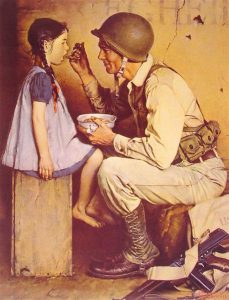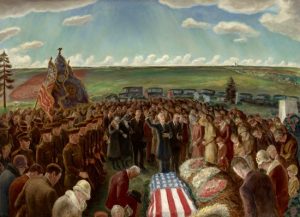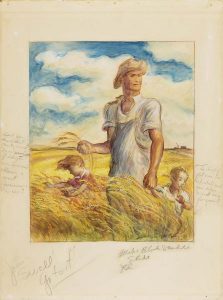
The American Way, Norman Rockwell, 1944, Oil on Canvas, Source: https://www.wikiart.org/en/norman-rockwell/the-american-way-1944
The American Way by Norman Rockwell is a reflection of the ideal American value of helping others, especially those who can’t help themselves. It features a young girl being fed by an American soldier. The young girl’s simple dress and bare feet show that she is likely lower class. The two figures’ surroundings consist of a cracked wall behind them, the box on which the girl sits, and the object on which the soldier is seated. This, along with the presence of the soldier shows that they are in a place that has likely been affected by the war (WWII). The girl’s parents are also not present which could indicate that they were killed in the war. This would have left the young girl helpless since she does not appear old enough to be able to take care of herself. So, the good soldier steps in to help, thus reflecting ideal American values. The soldier’s gun is also by his side showing that he is ready to fight if he needs to. The presence of the gun also reflects the duality of the soldier. He uses that gun to do his job, which involves killing people, but he has put the gun aside to help the young girl showing that there is more to the soldier than just someone who kills people. Not only does the soldier risk his life each day to fight for his country, but he is also willing to go out of his way to help those who cannot help themselves, such as the little girl in the painting. This unselfish will to help others is the true “American way”.

